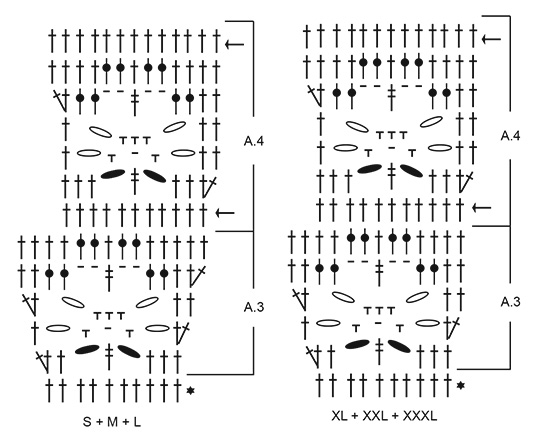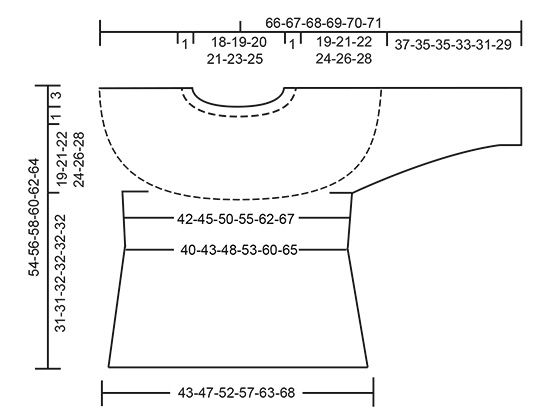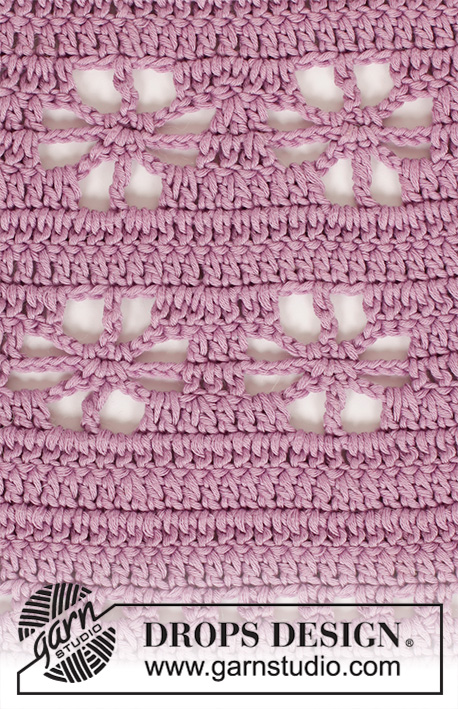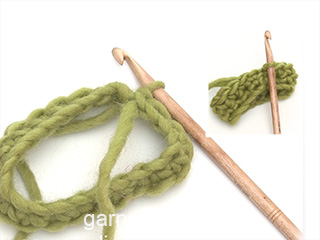Daisy Chain |
||||||||||||||||||||||||||||||||||
 |
 |
|||||||||||||||||||||||||||||||||
Crocheted jumper with round yoke in DROPS Muskat. Piece is crocheted top down with lace pattern. Size: S - XXXL
DROPS 201-5 |
||||||||||||||||||||||||||||||||||
|
EXPLANATION FOR THE PATTERN: ---------------------------------------------------------- CROCHET INFORMATION: Work every row back and forth and work together at the end/beginning of every row as follows: Beginning every row with treble crochets with 3 chain stitches (= first treble crochet) and finish with 1 slip stitch in 3rd chain stitch at beginning of row, turn piece. Begin every row with double crochets with 1 chain stitch (does not replace first double crochet) and finish with 1 slip stitch in first double crochet, turn piece. INCREASE/DECREASE TIP: To calculate how to increase/decrease evenly, use the total number of stitches (e.g. 93 stitches) and divide stitches by number of increases/decreases to be done (e.g. 7) = 13.3. I.e. in this example increase by working 2 double crochets in same stitch in approx. every 13th stitch. To decrease evenly in this example work every 12th and 13th stitch together, i.e. work 2 treble crochets together as follows: * Make 1 yarn over, insert hook in next stitch, get yarn, make 1 yarn over and pull yarn through the 2 first loops on hook *, repeat from *-* 1 more time, make 1 yarn over and pull yarn through all 3 loops on hook (= 1 treble crochet decreased). PATTERN: See diagrams A.1 to A.5. Choose diagram for your size (applies to A.3 and A.4). ---------------------------------------------------------- START THE PIECE HERE: ---------------------------------------------------------- JUMPER - SHORT OVERVIEW OF THE PIECE: Work yoke and body back and forth (i.e. alternately from right and wrong side) and work together at the end of every row, top down. Work sleeves back and forth but work piece together at the end of every row, top down. YOKE: Work 109-114-118-123-129-133 chain stitches on hook size 4 mm with Muskat and form a ring with 1 slip stitch in first chain stitch. Work 1 chain stitch - read CROCHET INFORMATION, work 1 double crochet in each of the next 3-1-5-3-2-6 chain stitches, * skip 1 chain stitch, 1 double crochet in each of the next 6 chain stitches *, work from *-* = 93-97-101-105-110-114 double crochets. Work first row from wrong side as follows: Work 1 double crochet in each double crochet and increase 7-15-23-23-30-30 stitches evenly – read INCREASE/DECREASE TIP = 100-112-124-128-140-144 double crochets. REMEMBER THE CROCHET TENSION! Work next row as follows from right side: Work A.1 over 16-20-24-24-24-24 stitches (= 4-5-6-6-6-6 repetitions of 4 stitches) (= half back piece), work A.2 over 2-2-2-3-3-4 stitches (= 2-2-2-3-3-4 repetitions of 1 stitch), A.1 over 12 stitches (= 3 repetitions), A.2 over 2-2-2-3-3-4 stitches (= 2-2-2-3-3-4 repetitions) (= sleeve), A.1 over 36-40-44-44-56-56 stitches (= 9-10-11-11-14-14 repetitions) (= front piece), A.2 over 2-2-2-3-3-4 stitches (= 2-2-2-3-3-4 repetitions), A.1 over 12 stitches (= 3 repetitions), A.2 over 2-2-2-3-3-4 stitches (= 2-2-2-3-3-4 repetitions) (= sleeve), A.1 over 16-20-24-24-24-24 stitches (= 4-5-6-6-6-6 repetitions = half back piece). Continue to work until A.1 and A.2 have been worked vertically (= 140-152-164-188-200-224 stitches) – AT THE SAME TIME on row marked with arrow adjust number of stitches by increasing/decreasing to 140-150-160-190-200-220 stitches. Piece measures approx. 6 cm. Work next row as follows from right side: Work A.3 over all stitches (= 14-15-16-19-20-22 repetitions over 10 stitches). Continue to work until A.3 has been worked vertically = 196-210-224-247-260-286 stitches. Piece measures approx. 11 cm. Work next row as follows from wrong side: Work A.4 over all stitches (= 18-19-20-22-24-26 repetitions over 11 stitches) – AT THE SAME TIME on first row adjust number of stitches by increasing/decreasing to 198-209-220-242-264-286 stitches so that repetitions fit. Continue to work until A.4 has been worked vertically (= 234-247-260-286-312-338 stitches), but on last row increase 0-11-19-8-6-10 stitches evenly = 234-258-279-294-318-348 stitches. Piece measures approx. 19 cm. SIZE S: If measurements are not correct, work A.5 over all stitches (= 78 repetitions of 3 stitches) until piece measures 19 cm – adjust so that next row is only with treble crochets. SIZE M-L-XL-XXL-XXXL: Then work A.5 over all stitches (= 86-93-98-106-116 repetitions of 3 stitches) until piece measures 21-22-24-26-28 cm – AT THE SAME TIME on 1st-2nd-2nd-4th-4th row increase 6-15-6-6-6 stitches evenly = 264-294-300-324-354 stitches. Continue until piece measures 21-22-24-26-28 cm, adjust so that next row is a row with only treble crochets. ALL SIZES: = 234-264-294-300-324-354 stitches. Now divide body and sleeves as follows (repeat A.5 vertically until finished measurements): Work as before over the first 35-38-42-44-50-54 stitches (= half back piece), skip the next 48-57-63-63-63-69 stitches (= sleeve), work 6-6-6-12-12-12 chain stitches (= mid under sleeve), work as before over the next 68-74-84-86-98-108 stitches (= front piece), skip the next 48-57-63-63-63-69 stitches (= sleeve), work 6-6-6-12-12-12 chain stitches (= mid under sleeve) and work as before over the remaining 35-38-42-44-50-54 stitches (= half back piece). Finish body and sleeves separately. NOW MEASURE THE PIECE FROM HERE! BODY: = 150-162-180-198-222-240 stitches. Continue pattern as before over all stitches (= 50-54-60-66-74-80 repetitions A.5 of 3 stitches). When piece measures 4 cm from division, decrease 3 treble crochets evenly on next row (adjust to decrease on a row with only treble crochets). Decrease like this every 4 cm 2 times in total = 144-156-174-192-216-234 stitches. For every decrease work 1 repetition less of A.5 in width. When piece measures 14 cm from division, increase 3 treble crochets evenly (adjust to increase on a row with only treble crochets). Increase like this every 4 cm 4 times in total = 156-168-186-204-228-246 stitches. For every increase work 1 repetition more of A.5 in width. Continue until piece measures 31-31-32-32-32-32 cm from division (50-52-54-56-58-60 cm from neck in the middle of front piece), finish after 1 row with treble crochets. Cut and fasten the yarn. SLEEVE: Work piece back and forth (i.e. alternately from right and wrong side) and work together with 1 slip stitch on every row. Begin by working in the 4th-4th-4th-7th-7th-7th chain stitch of the 6-6-6-12-12-12 chain stitches worked in armhole on body as follows: Work 1 slip stitch, 3 chain stitches (= 1 treble crochet), 1 treble crochet in each of the next 2-2-2-6-6-6 chain stitches, A.5 over the next 48-57-63-63-63-69 treble crochets (= 16-19-21-21-21-23 times in width) and finish with 1 treble crochet in each of the last 3-3-3-6-6-6 chain stitches under sleeve = 54-63-69-75-75-81 stitches. Insert 1 marker thread at the beginning of row. Continue pattern as before over all stitches (= 18-21-23-25-25-27 repetitions of 3 stitches). When piece measures 3 cm from division, decrease 3 treble crochets evenly on next row (adjust to decrease on a row with only treble crochets). Decrease like this every 5½-3½-3-2-2-2 cm 5-8-9-11-10-11 times in total = 39-39-42-42-45-48 stitches. For every decrease work 1 repetition less of A.5 in width. Continue until piece measures 37-35-35-33-31-29 cm from division (shorter measurements in the larger sizes because of longer yoke), finish after 1 row with only treble crochets. Cut and fasten the yarn. Work the other sleeve the same way. NECK EDGE: Work back and forth over chain stitch row in neck as follows: ROW 1 (= from right side): Begin mid back, fasten yarn to piece with 1 slip stitch in a double crochet, work 2 chain stitches (= 1 half treble crochet), work 1 half treble crochet in every double crochet the entire row = 93-97-101-105-110-114 half treble crochets. ROW 2 (= from wrong side): Work 1 double crochet in every half treble crochet = 93-97-101-105-110-114 double crochets. Cut and fasten the yarn. |
||||||||||||||||||||||||||||||||||
Diagram explanations |
||||||||||||||||||||||||||||||||||
|
||||||||||||||||||||||||||||||||||

|
||||||||||||||||||||||||||||||||||

|
||||||||||||||||||||||||||||||||||

|
||||||||||||||||||||||||||||||||||
|
Have you made this or any other of our designs? Tag your pictures in social media with #dropsdesign so we can see them! Do you need help with this pattern?You'll find tutorial videos, a Comments/Questions area and more by visiting the pattern on garnstudio.com. © 1982-2024 DROPS Design A/S. We reserve all rights. This document, including all its sub-sections, has copyrights. Read more about what you can do with our patterns at the bottom of each pattern on our site. |
||||||||||||||||||||||||||||||||||
























































Comments / Questions (48)
Chiedo scusa, magari la mia è una domanda stupida. Che cosa significa (600-650-750-800-900-950 g colore 04)? Non riesco a capire quale sia la quantità esatta di filato necessaria per la realizzazione
31.03.2020 - 12:38DROPS Design answered:
Buongiorno Giovanna. I numeri indicano la quantità in grammi necessaria a seconda della taglia. Quindi p.es per la taglia S occorrono 600 g, per la taglia M 650 g e via di seguito. Buon lavoro!
01.04.2020 - 08:29I\'m having trouble getting the tension - it should be 18 treble crochets in width 10 10 cm, but mine only measures 9 cm, but the vertical, instead of 9 treble rows for 10 cm, I already have 9 cm when I\'ve only done 5 treble rows. It\'s a long time since I have crocheted but think I must be doing something wrong. Please help.
01.03.2020 - 15:57DROPS Design answered:
Dear Mrs Shearing, the crochet tension is quite individual, make sure to adjust hook size to get the correct tension in width and try to make your stitches somewhat less high to get the right tension in height. read more about tension here. Happy crocheting!
02.03.2020 - 11:37Vorrei sapere se esiste un filato adatto al periodo estivo più leggero del cotone,
26.02.2020 - 11:37DROPS Design answered:
Buongiorno Rocchina. Può provare con il filato Bomull lin, un misto cotone lino. Appartiene ad un altro gruppo di filati rispetto al Muskat. Verifichi se riesce ad ottenere lo stesso campione indicato nel modello. Per ulteriori consigli, può rivolgersi anche al suo rivenditore Drops di fiducia. Buon lavoro!
26.02.2020 - 13:33Hoe begin ik met regel 3 van patroon A.5 ? Eerst 3 losse als eerste stokje maar hoe dan verder?? Met de losse en minderen?
19.08.2019 - 17:31DROPS Design answered:
Dag Robby,
Op toer 3 begin je met 1 losse, dan sla je 1 stokje van de vorige toer over en haak je 2 stokjes samen, dan haak je nog een losse. Vervolgens begin je weer met 1 losse. Het komt er dus op neer dat je steeds 2 lossen haakt, 1 stokje van de vorige toer over slaat en dan 2 stokjes samen haakt.
01.09.2019 - 12:47I've never followed a pattern like this before and I'm getting very confused. I'm up to the 4th row of the Yoke and can't figure out how to follow the pattern any further. Please help, I don't want to give up.
10.08.2019 - 10:41DROPS Design answered:
Dear Mrs Mardones Cortes, see how to read crochet diagrams here - ie work A.1 and A.2 reading from the right towards the left from RS and from the left towards the right from WS. Happy crocheting!
12.08.2019 - 07:24Jeg skjønner ikke hvordan jeg skal få 164 m før siste omg av mønster A1 og A2. Siste omg skal jo brukes til å justere ned til 160 m. Hvis jeg har skjønt mønsteret riktig økes det tilsammen 8 m på første omg og 16 m på andre omg. Tilsammen 148 m. Etter dette ingen øking før justering på siste omg. Hva er det jeg gjør feil
07.08.2019 - 12:40DROPS Design answered:
Hei Elin. Hekle 4.rad/siste rad av A.1 og A.2 slik: Hekle A.1 over 24 masker (halve bakstykket), hekle A.2 2 ganger (12 masker), hekle A.1 over 12 masker, hekle A.2 2 ganger (12 masker), hekle A.1 over 44 masker (forstykket), hekle A.2 2 ganger (12 masker), hekle A.1 over 12 masker, hekle A.2 2 ganger (12 masker), og hekle A.1 over 12 masker (andre halvdel av bakstykket). (24+12+12+12+44+12+12+12+24 = 164 masker). Etter siste rad i diagram A.1 og A.2 er det 164 masker MEN samtidig på siste rad skal maskeantallet justeres til 160 masker. Det kan du f.eks gjør ved å ikke hekle 2 staver i 1 stav i 4 av de 8 gangene du hekler A.2 på siste rad. God Fornøyelse!
09.09.2019 - 13:56Me parece genial lo que haces pero seria muy genial siincluyeras un video y pienso es más fácil seguir las instrucciones con gráficos un pasoa paso ayudaría mucho en general me gusta mucho lo que haces.
20.07.2019 - 07:16This is a lovely pattern. Do you have it in children's sizes? I can't wait to make it using various yarns for different weather. Instead of two rows of daisies, I would like to just make one row so my bra doesn't show. Awesome pattern! One of the best I've seen from Drops. Thanks so much!
05.06.2019 - 16:02DROPS Design answered:
Dear Alyce, this pattern is not available in children size but you can find a similar jacket to inspire you. Happy crocheting!
05.06.2019 - 16:09Hello, I have a question regarding the transition between A.4 and A.5. It is written that we have to work A.5 over all stitches and "at the same time on 1st-2nd-2nd-4th-4th row increase 6-15-6-6-6 stitches evenly" = 294 stitches for M size. Firstly, why are the 2nd and the 4th row repeated twice? Secondly, an increase of 6+15+6+6+6 would end up in 297 stitches for size M instead of 294. Can you clarify what that means? Thank you!
27.05.2019 - 16:53DROPS Design answered:
Dear Kalina, each number refers to the size in the same order as given under header, ie in size M (= 2nd size) you increase 15 stitches (= 2nd number) evenly on 2nd row (= 2nd number). Happy crocheting!
28.05.2019 - 09:02Salve perché sono scomparsi lo schema 5 e l'immagine del maglioncino indossato dalla modella grazie
14.05.2019 - 17:25DROPS Design answered:
Buongiorno Barbara, il diagramma A.5 è presente, così come l'immagine del maglione: ha provato con un altro browser o a svuotare la cache? Buon lavoro!
14.05.2019 - 17:51